Abstract
Endothelial injury may contribute to the augmented coronary vascular tone seen in myocardial ischemia by impairing endothelial production or release of vasodilators. In vitro reactivity of arterial rings was studied after 60 min of coronary occlusion and 60 min of reperfusion in anesthetized dogs. Ischemia without reperfusion blunted contractile reactivity to potassium chloride (KCl), whereas ischemia plus reperfusion augmented contractile responses to both KCl and ergonovine. The response to acetylcholine, an endothelium-dependent vasodilator, was abolished in reperfused arteries, whereas the response to nitroprusside, an endothelium-independent vasodilator, was intact. Verapamil pretreatment restored KCl contractile responses to normal in reperfused coronary rings and partially restored endothelium-dependent relaxation. Electron microscopy revealed a nondenuding epicardial coronary endothelial injury in reperfused arteries. These data support the hypothesis that reperfusion of ischemic myocardium augments reactivity to vasoconstrictor agents by causing endothelial cell damage, excessive calcium influx, and loss of modulating vasodilator function.
Full text
PDF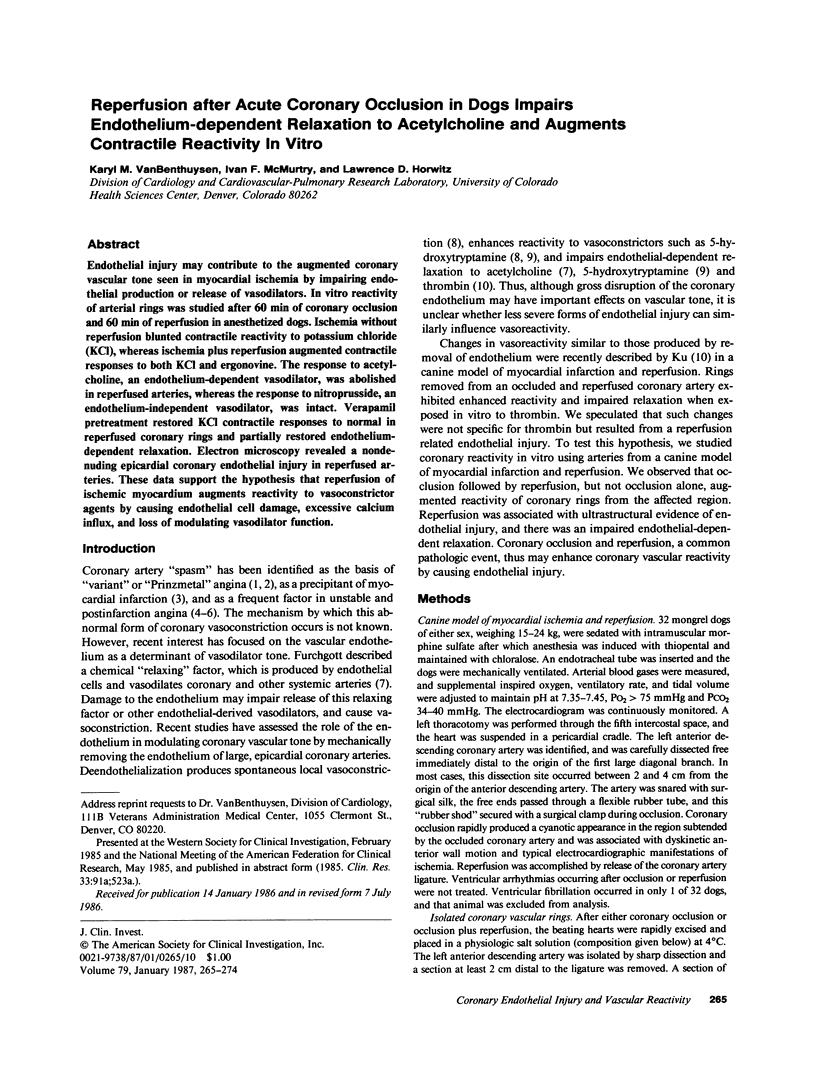
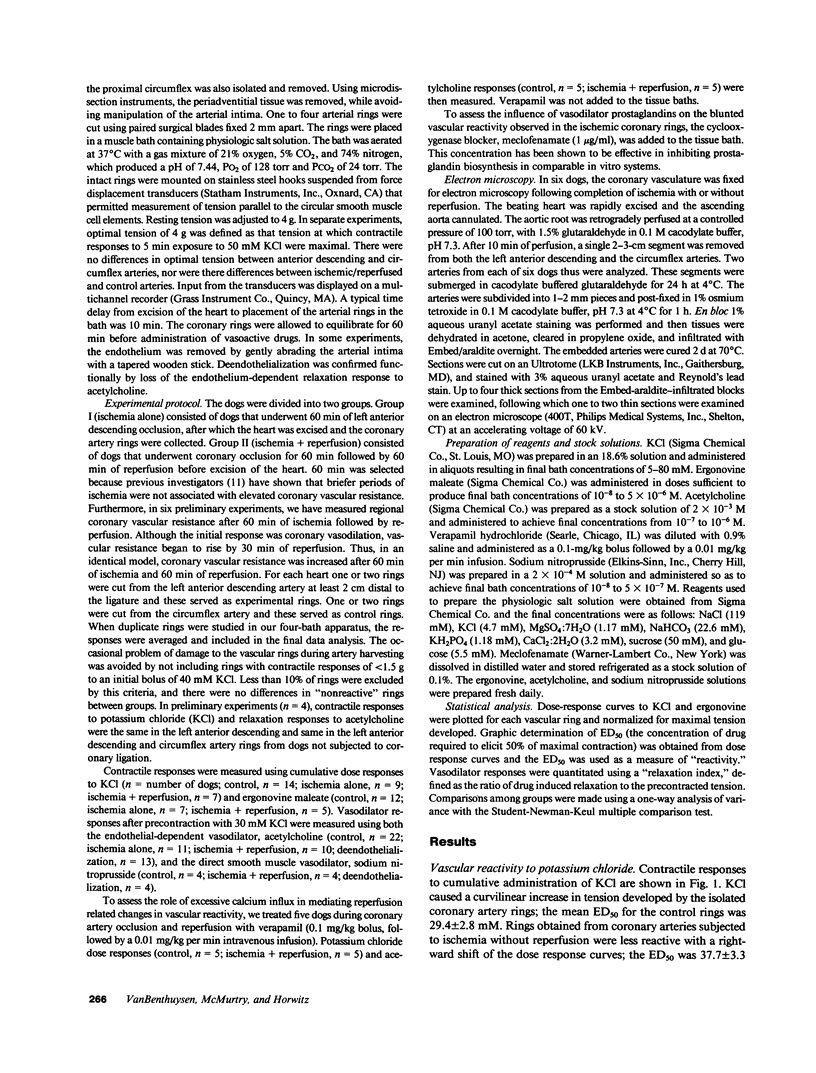
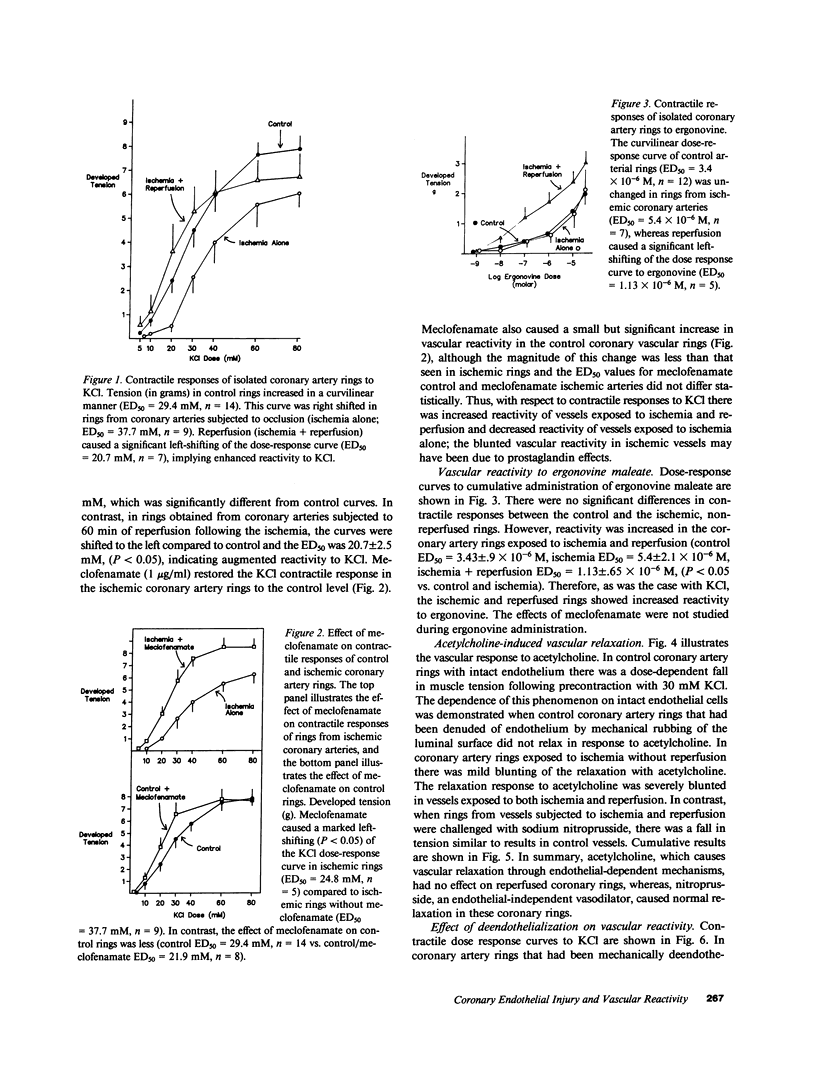
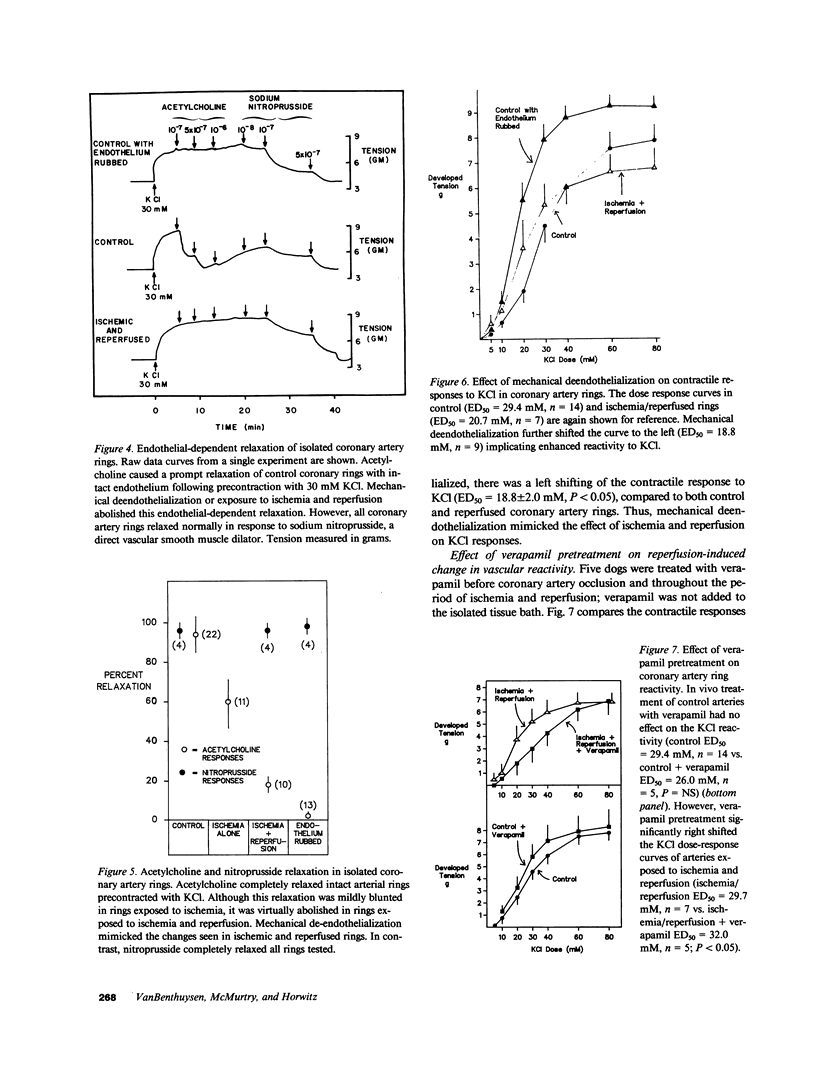
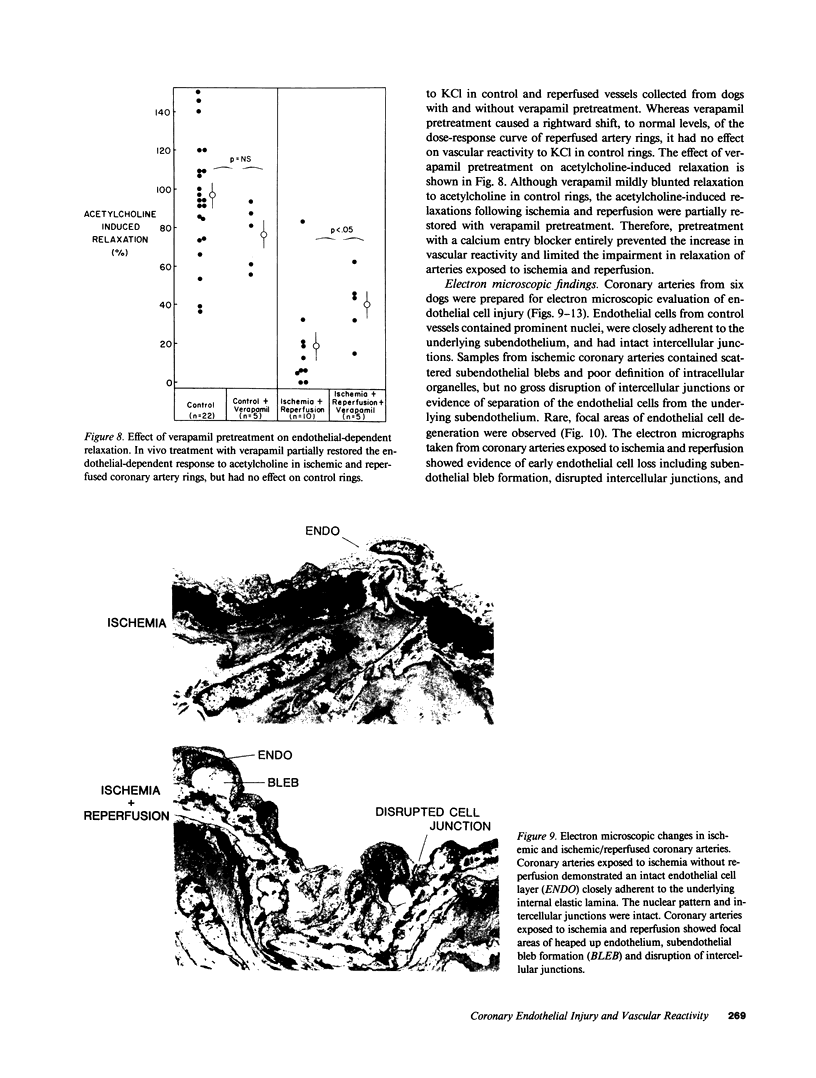
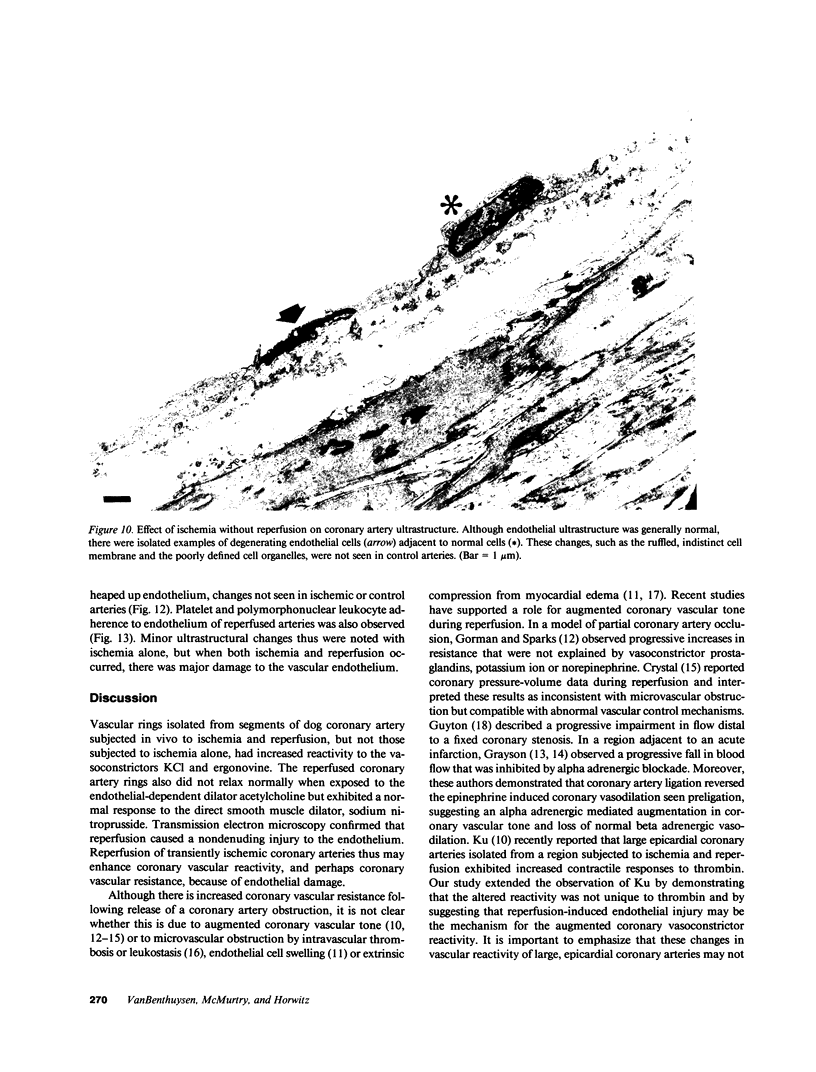
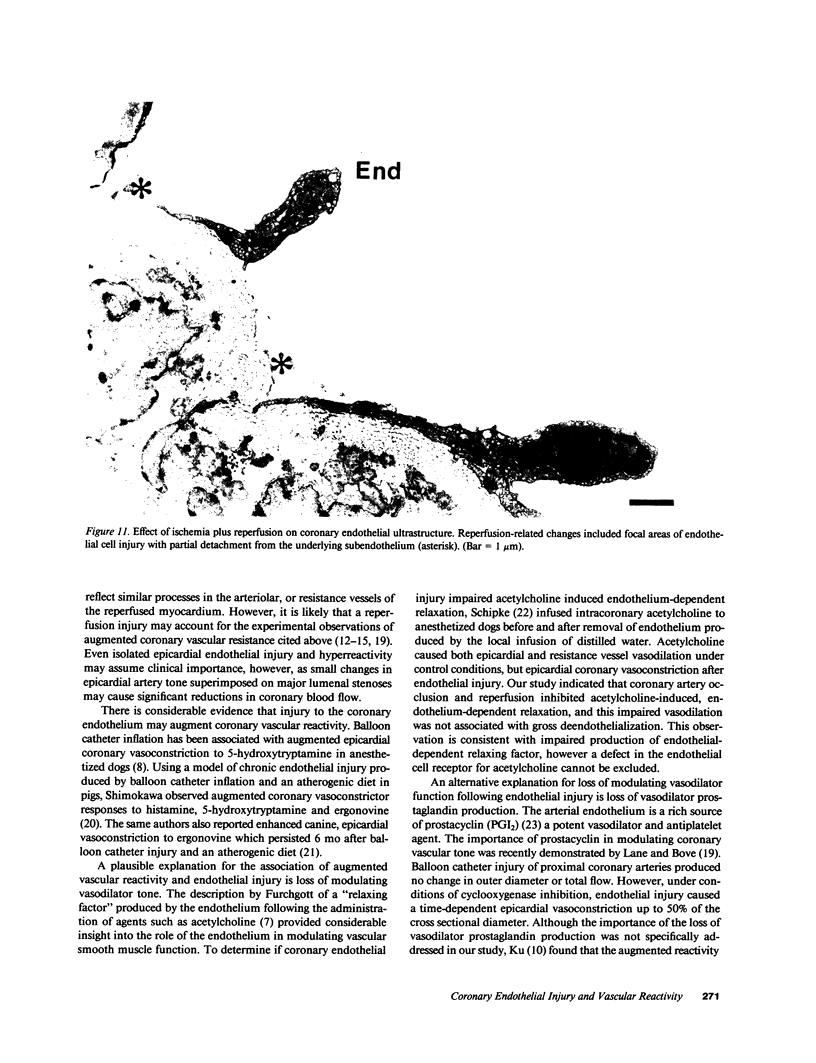
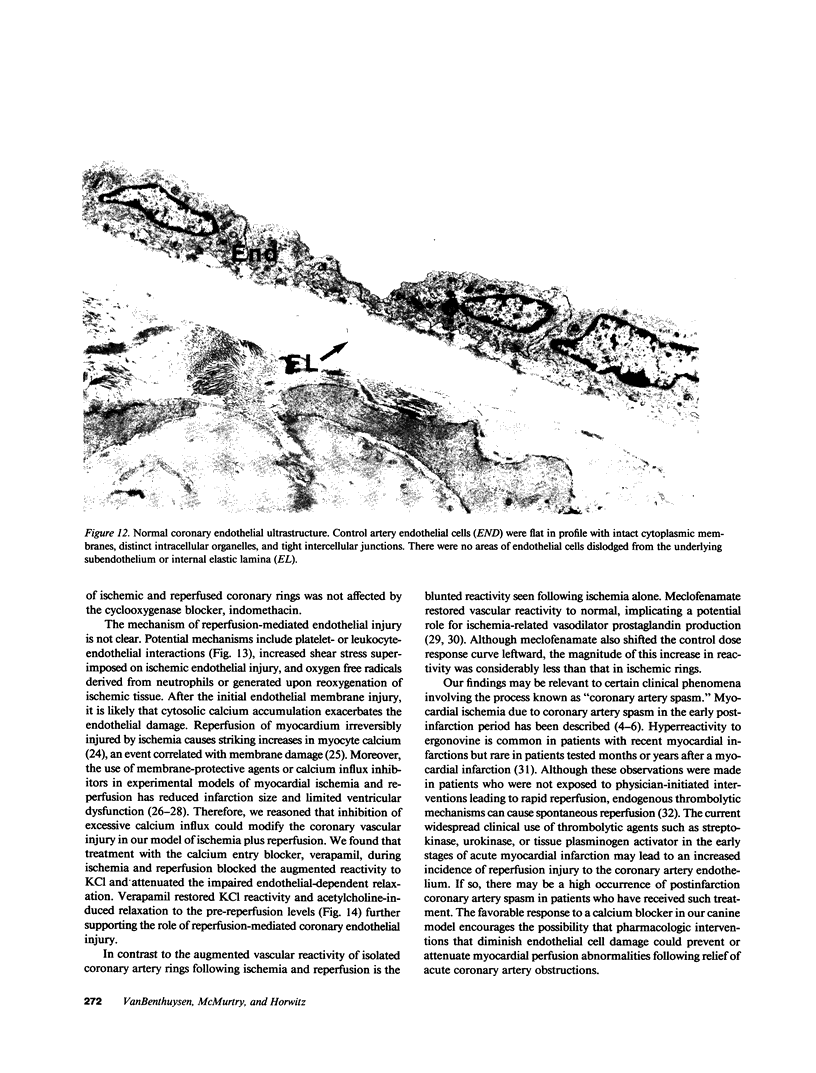
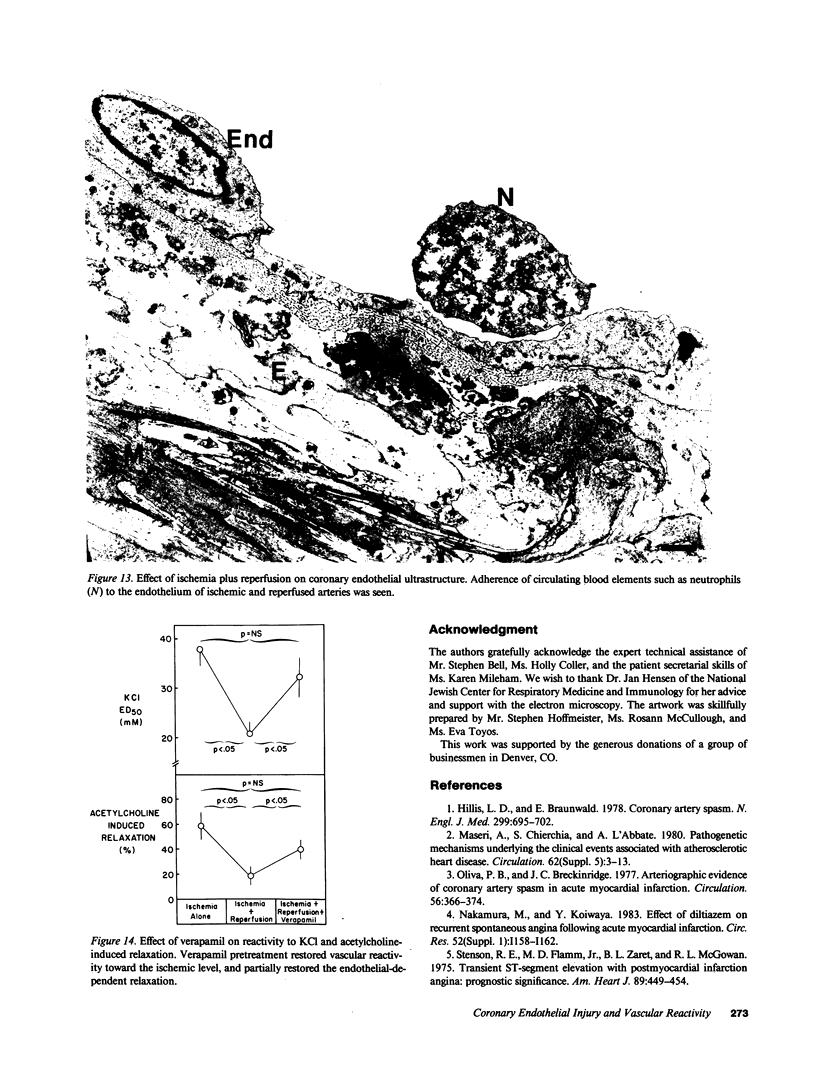
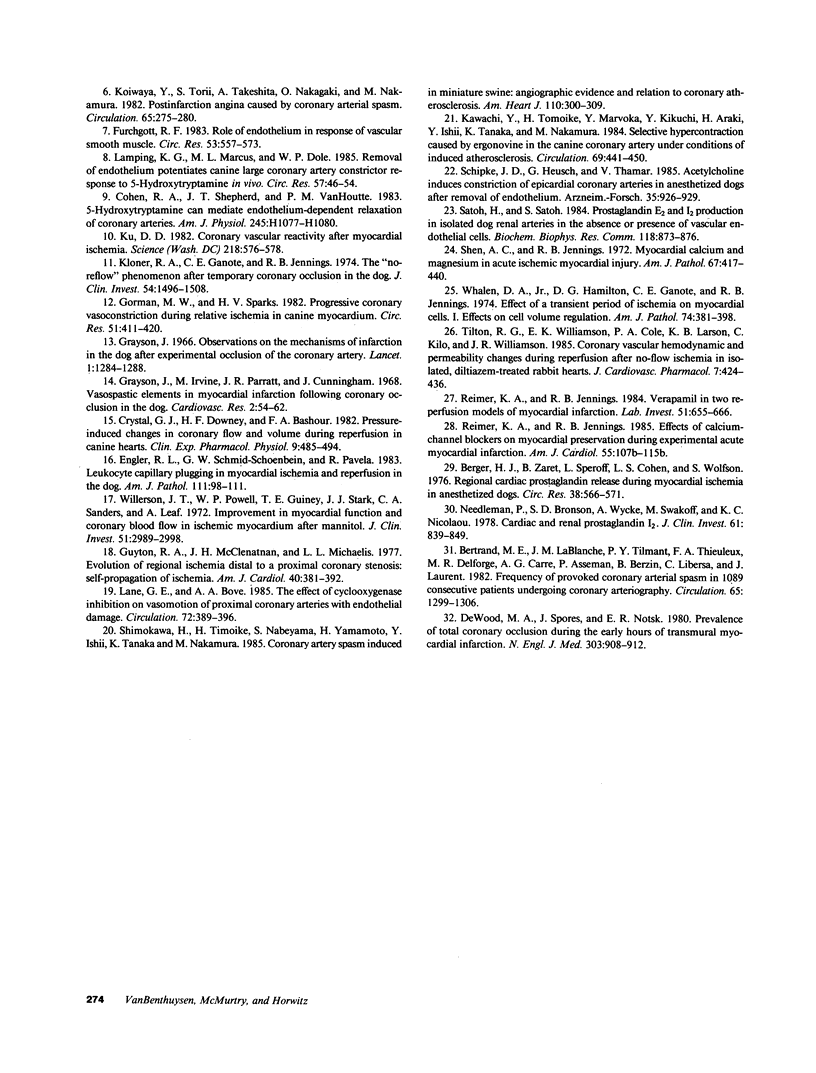
Images in this article
Selected References
These references are in PubMed. This may not be the complete list of references from this article.
- Berger H. J., Zaret B. L., Speroff L., Cohen L. S., Wolfson S. Regional cardiac prostaglandin release during myocardial ischemia in anesthetized dogs. Circ Res. 1976 Jun;38(6):566–571. doi: 10.1161/01.res.38.6.566. [DOI] [PubMed] [Google Scholar]
- Bertrand M. E., LaBlanche J. M., Tilmant P. Y., Thieuleux F. A., Delforge M. R., Carre A. G., Asseman P., Berzin B., Libersa C., Laurent J. M. Frequency of provoked coronary arterial spasm in 1089 consecutive patients undergoing coronary arteriography. Circulation. 1982 Jun;65(7):1299–1306. doi: 10.1161/01.cir.65.7.1299. [DOI] [PubMed] [Google Scholar]
- Crystal G. J., Downey H. F., Bashour F. A. Pressure-induced changes in coronary flow and volume during reperfusion in canine hearts. Clin Exp Pharmacol Physiol. 1982 Sep-Oct;9(5):485–494. doi: 10.1111/j.1440-1681.1982.tb00822.x. [DOI] [PubMed] [Google Scholar]
- Engler R. L., Schmid-Schönbein G. W., Pavelec R. S. Leukocyte capillary plugging in myocardial ischemia and reperfusion in the dog. Am J Pathol. 1983 Apr;111(1):98–111. [PMC free article] [PubMed] [Google Scholar]
- Furchgott R. F. Role of endothelium in responses of vascular smooth muscle. Circ Res. 1983 Nov;53(5):557–573. doi: 10.1161/01.res.53.5.557. [DOI] [PubMed] [Google Scholar]
- Gorman M. W., Sparks H. V., Jr Progressive coronary vasoconstriction during relative ischemia in canine myocardium. Circ Res. 1982 Oct;51(4):411–420. doi: 10.1161/01.res.51.4.411. [DOI] [PubMed] [Google Scholar]
- Grayson J., Irvine M., Parratt J. R., Cunningham J. Vasospastic elements in myocardial infarction following coronary occlusion in the dog. Cardiovasc Res. 1968 Jan;2(1):54–62. doi: 10.1093/cvr/2.1.54. [DOI] [PubMed] [Google Scholar]
- Grayson J., Lapin B. A. Observations on the mechanisms of infarction in the dog after experimental occlusion of the coronary artery. Lancet. 1966 Jun 11;1(7450):1284–1288. doi: 10.1016/s0140-6736(66)91199-8. [DOI] [PubMed] [Google Scholar]
- Guyton R. A., McClenathan J. H., Michaelis L. L. Evolution of regional ischemia distal to a proximal coronary stenosis: self-propagation of ischemia. Am J Cardiol. 1977 Sep;40(3):381–392. doi: 10.1016/0002-9149(77)90160-6. [DOI] [PubMed] [Google Scholar]
- Hillis L. D., Braunwald E. Coronary-artery spasm. N Engl J Med. 1978 Sep 28;299(13):695–702. doi: 10.1056/NEJM197809282991305. [DOI] [PubMed] [Google Scholar]
- Kawachi Y., Tomoike H., Maruoka Y., Kikuchi Y., Araki H., Ishii Y., Tanaka K., Nakamura M. Selective hypercontraction caused by ergonovine in the canine coronary artery under conditions of induced atherosclerosis. Circulation. 1984 Feb;69(2):441–450. doi: 10.1161/01.cir.69.2.441. [DOI] [PubMed] [Google Scholar]
- Kloner R. A., Ganote C. E., Jennings R. B. The "no-reflow" phenomenon after temporary coronary occlusion in the dog. J Clin Invest. 1974 Dec;54(6):1496–1508. doi: 10.1172/JCI107898. [DOI] [PMC free article] [PubMed] [Google Scholar]
- Koiwaya Y., Torii S., Takeshita A., Nakagaki O., Nakamura M. Postinfarction angina caused by coronary arterial spasm. Circulation. 1982 Feb;65(2):275–280. doi: 10.1161/01.cir.65.2.275. [DOI] [PubMed] [Google Scholar]
- Ku D. D. Coronary vascular reactivity after acute myocardial ischemia. Science. 1982 Nov 5;218(4572):576–578. doi: 10.1126/science.7123259. [DOI] [PubMed] [Google Scholar]
- Lamping K. G., Marcus M. L., Dole W. P. Removal of the endothelium potentiates canine large coronary artery constrictor responses to 5-hydroxytryptamine in vivo. Circ Res. 1985 Jul;57(1):46–54. doi: 10.1161/01.res.57.1.46. [DOI] [PubMed] [Google Scholar]
- Maseri A., Chierchia S., L'Abbate A. Pathogenetic mechanisms underlying the clinical events associated with atherosclerotic heart disease. Circulation. 1980 Dec;62(6 Pt 2):V3–13. [PubMed] [Google Scholar]
- Nakamura M., Koiwaya Y. Effect of diltiazem on recurrent spontaneous angina after acute myocardial infarction. Circ Res. 1983 Feb;52(2 Pt 2):I158–I162. [PubMed] [Google Scholar]
- Needleman P., Bronson S. D., Wyche A., Sivakoff M., Nicolaou K. C. Cardiac and renal prostaglandin I2. Biosynthesis and biological effects in isolated perfused rabbit tissues. J Clin Invest. 1978 Mar;61(3):839–849. doi: 10.1172/JCI108998. [DOI] [PMC free article] [PubMed] [Google Scholar]
- Oliva P. B., Breckinridge J. C. Arteriographic evidence of coronary arterial spasm in acute myocardial infarction. Circulation. 1977 Sep;56(3):366–374. doi: 10.1161/01.cir.56.3.366. [DOI] [PubMed] [Google Scholar]
- Reimer K. A., Jennings R. B. Effects of calcium-channel blockers on myocardial preservation during experimental acute myocardial infarction. Am J Cardiol. 1985 Jan 25;55(3):107B–115B. doi: 10.1016/0002-9149(85)90619-8. [DOI] [PubMed] [Google Scholar]
- Reimer K. A., Jennings R. B. Verapamil in two reperfusion models of myocardial infarction. Temporary protection of severely ischemic myocardium without limitation of ultimate infarct size. Lab Invest. 1984 Dec;51(6):655–666. [PubMed] [Google Scholar]
- Satoh H., Satoh S. Prostaglandin E2 and I2 production in isolated dog renal arteries in the absence or presence of vascular endothelial cells. Biochem Biophys Res Commun. 1984 Feb 14;118(3):873–876. doi: 10.1016/0006-291x(84)91476-1. [DOI] [PubMed] [Google Scholar]
- Schipke J. D., Heusch G., Deussen A., Thämer V. Acetylcholine induces constriction of epicardial coronary arteries in anesthetized dogs after removal of endothelium. Arzneimittelforschung. 1985;35(6):926–929. [PubMed] [Google Scholar]
- Shen A. C., Jennings R. B. Myocardial calcium and magnesium in acute ischemic injury. Am J Pathol. 1972 Jun;67(3):417–440. [PMC free article] [PubMed] [Google Scholar]
- Shimokawa H., Tomoike H., Nabeyama S., Yamamoto H., Ishii Y., Tanaka K., Nakamura M. Coronary artery spasm induced in miniature swine: angiographic evidence and relation to coronary atherosclerosis. Am Heart J. 1985 Aug;110(2):300–310. doi: 10.1016/0002-8703(85)90148-6. [DOI] [PubMed] [Google Scholar]
- Stenson R. E., Flamm M. D., Zaret B. L., McGowan R. L. Transient ST-segment elevation with postmyocardial infarction angina: prognostic significance. Am Heart J. 1975 Apr;89(4):449–454. doi: 10.1016/0002-8703(75)90150-7. [DOI] [PubMed] [Google Scholar]
- Tilton R. G., Williamson E. K., Cole P. A., Larson K. B., Kilo C., Williamson J. R. Coronary vascular hemodynamic and permeability changes during reperfusion after no-flow ischemia in isolated, diltiazem-treated rabbit hearts. J Cardiovasc Pharmacol. 1985 May-Jun;7(3):424–436. doi: 10.1097/00005344-198505000-00003. [DOI] [PubMed] [Google Scholar]
- Whalen D. A., Jr, Hamilton D. G., Ganote C. E., Jennings R. B. Effect of a transient period of ischemia on myocardial cells. I. Effects on cell volume regulation. Am J Pathol. 1974 Mar;74(3):381–397. [PMC free article] [PubMed] [Google Scholar]
- Willerson J. T., Powell W. J., Jr, Guiney T. E., Stark J. J., Sanders C. A., Leaf A. Improvement in myocardial function and coronary blood flow in ischemic myocardium after mannitol. J Clin Invest. 1972 Dec;51(12):2989–2998. doi: 10.1172/JCI107126. [DOI] [PMC free article] [PubMed] [Google Scholar]








